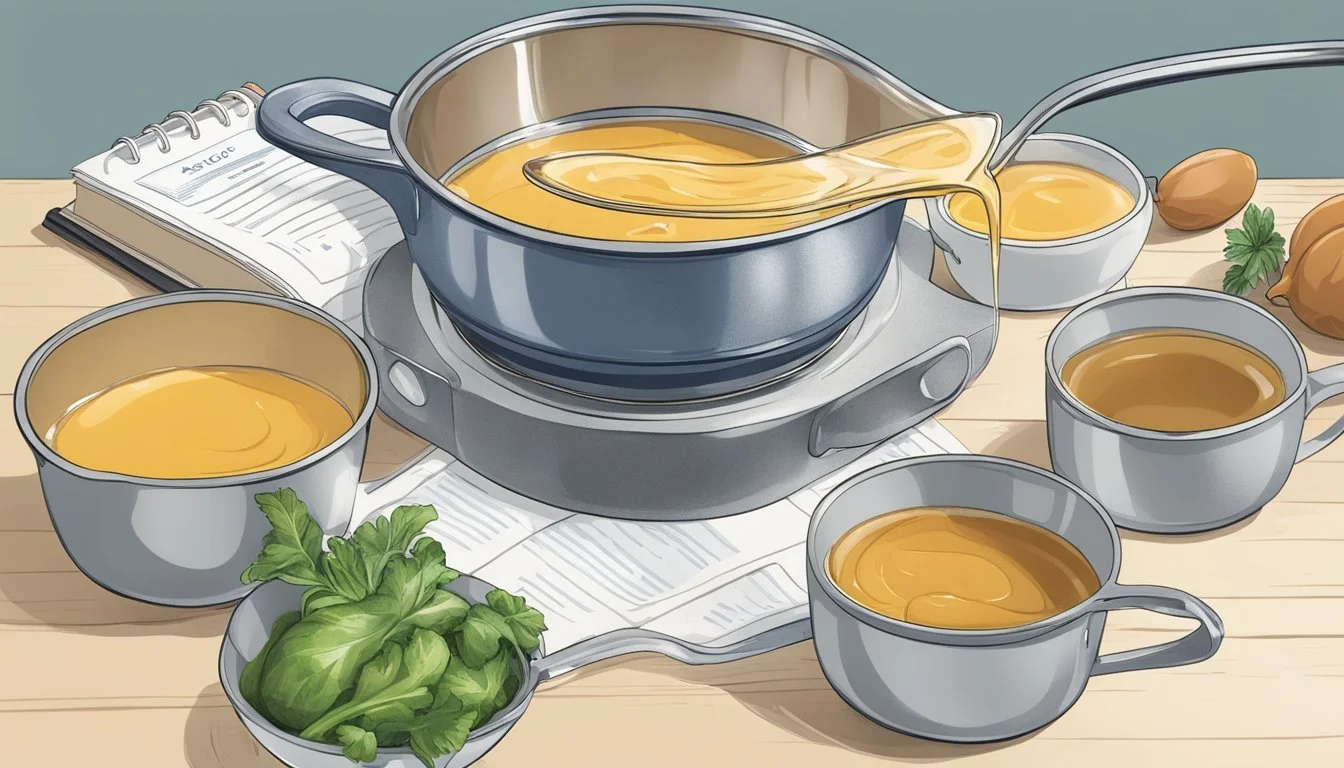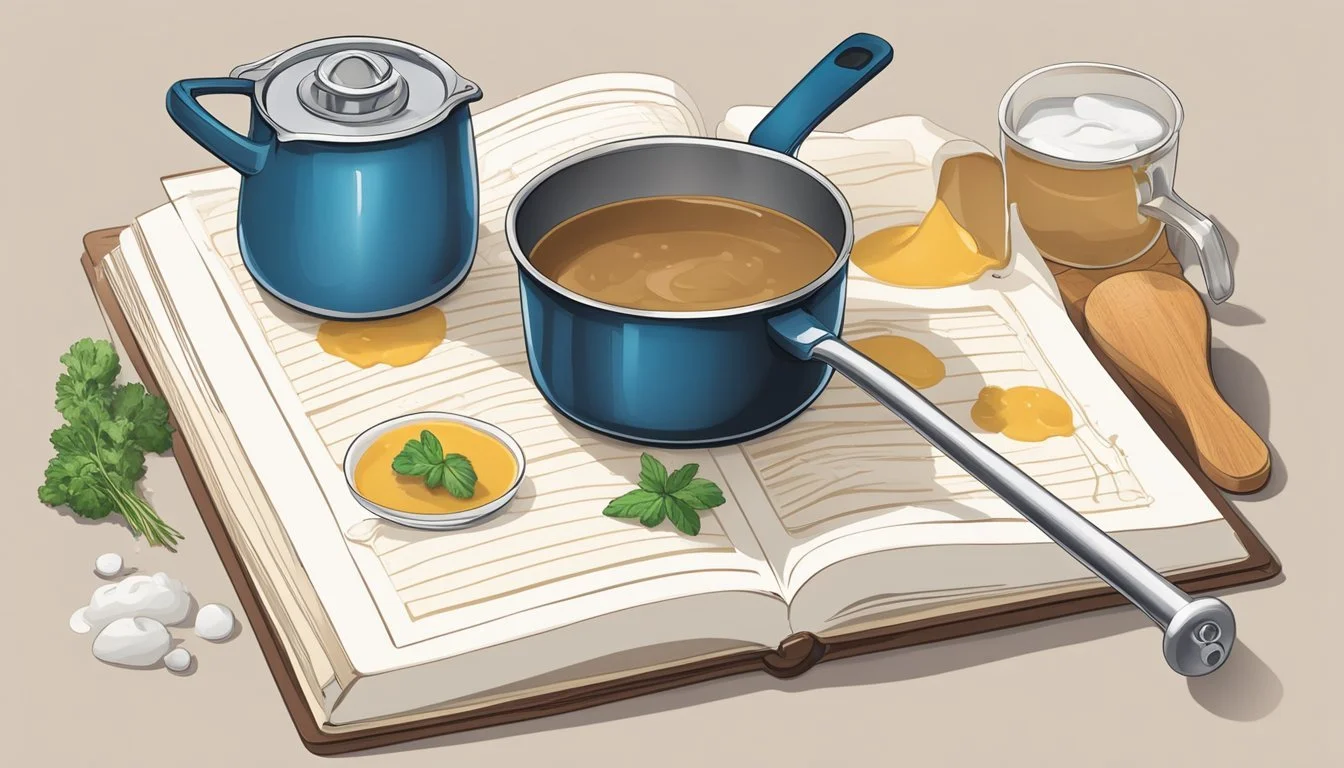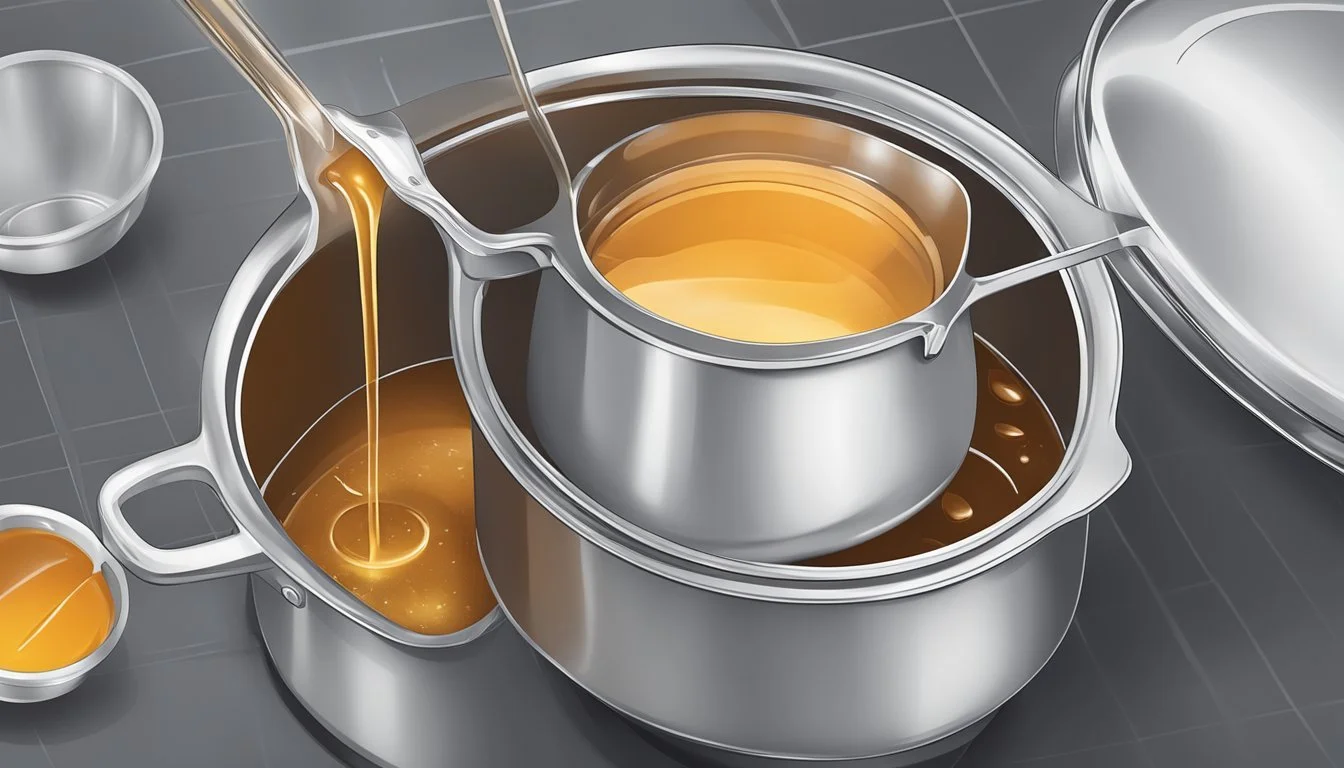How to Measure the Right Amount of Liquid for Perfect Gravy Consistency
Crafting a perfect homemade gravy is as much about the right ingredients as it is about the accurate proportions. Gravy, with its rich, savory flavor, is a crucial component of many meals, enhancing dishes like roasted meats (What wine goes well with roasted meats?), mashed potatoes, and more. The foundation of a successful gravy lies in the careful balance of flour and liquid, which, when combined correctly, yield a sauce that's neither too thick nor too watery.
Understanding the liquid-to-thickener ratio is key in gravy-making. This ratio ensures the resulting texture is velvety and lump-free. In traditional recipes, the ratio of flour to liquid typically ranges from 1:2 to 1:3, depending on whether a thicker or thinner consistency is desired. Liquids commonly used include broth, stock, meat drippings, or water, each contributing to the depth of flavor in the final product.
When cooking homemade gravy, the process begins by creating a roux—a mixture of fat and flour—to which the liquid is gradually added. Constant whisking during this stage is crucial to avoiding lumps, achieving a homogenous mix, and allowing the gravy to thicken to the right consistency upon gentle cooking. The cook's choice in liquid, coupled with accurate measurement and attentive preparation, culminates in a gravy that's a testament to their culinary prowess and complements the meal exquisitely.
Understanding Gravy Components
Creating the perfect gravy requires precision in measuring key components. The quality and proportion of these elements define the flavor and texture of the final product.
Defining Gravy
Gravy is a sauce often derived from the juices that run naturally from meat or vegetables during cooking. It is traditionally thickened with a starch and seasoned to enhance its taste. Gravy can be served over the main dish or as a side to add moisture and richness.
Key Ingredients
The foundation of any gravy is its key ingredients: a combination of fat and liquid, along with flavoring agents. Below is a breakdown of these essential components:
Fat: The source of richness and a carrier for the base flavor; common options include butter, oil, or drippings from cooked meat.
Liquid: Typically stock, broth, or cream, it forms the body of the gravy and determines the consistency.
Flavor: Achieved by the careful selection and balance of seasonings, which can include salt, pepper, herbs, and meat juices.
Role of Fats and Liquids
The interaction of fats and liquids is crucial in gravy preparation, with each playing a distinct role in the process:
Roux: A mixture of fat (commonly butter) and flour, cooked together to serve as the thickening agent. The roux must be well-blended to prevent lumps in the gravy.
Fat Type Common Ratios Butter 1:1 with flour Oil 1:1 with flour Meat Drippings Variable
Stock/Broth: This is gently incorporated into the roux to form the basis of the liquid component. Stock and broth must be measured accurately to balance the flavors and ensure the correct consistency.
Cream: Optionally added for a creamy texture and flavor, it should be introduced with care to not overwhelm the other ingredients.
It's these components, when measured correctly, that determine the success of a gravy's final flavor and texture.
Preparing the Base
The foundation of a great gravy lies in its base, where the flavors are built and the texture is established. A good base will lead to a smooth and rich gravy, integral to complementing your meat dish.
Creating a Roux
A roux is the thickening agent for the gravy, typically made from equal parts of flour and fat. Butter is often preferred for its flavor, but oil is a viable alternative for different dietary needs. To make a roux, melt the fat over medium heat, then whisk in an equal amount of flour to form a paste. This mixture should be cooked until it reaches a light tan color, ensuring the raw flour taste is gone.
Roux proportions:
1 part fat (butter/oil)
1 part flour (all-purpose)
Using Pan Drippings
For gravies with depth, using pan drippings from roasted meat is key. After removing the meat, pour the drippings into a separator, allowing the fat to rise. The flavorsome liquid left is the essence that will be incorporated into the base. If the fat is to be used, skim off the required amount for the roux. Mix the flavorful liquid with additional stock if needed to reach the desired volume for the gravy.
Steps for drippings:
Pour drippings into a separator
Skim fat for roux if using
Reserve flavorful liquid
Selecting the Right Fat
The choice of fat can vary depending on the desired flavor and the type of meat the drippings came from. Butter imparts a rich taste and is often used for poultry-based gravies, while oil is better for high-heat cooking, and options like bacon fat can be used for a more robust flavor with red meats. The selected fat will be combined with flour to create the roux and form the gravy's thickening base.
Fat options:
Butter: Rich flavor, ideal for poultry.
Oil: High smoke point, good for vegetarians.
Meat-specific fats (e.g., bacon fat): Strong flavor, pairs with respective meats.
Measuring Liquids for Gravy
The foundation of a perfect gravy lies in the precise measurement and the correct ratio of liquids involved. This section focuses on identifying the ideal mix of liquids and tweaking their quantities to achieve the desired consistency.
Ideal Liquid Ratios
For most gravy recipes, the standard measurement for liquid to flour is about 1:2 to 1:3, where for every one part flour, two to three parts liquid are used. This ratio provides a starting point for gravy that is neither too thick nor too thin. In terms of volume:
Thin Gravy: Use 3 parts liquid to 1 part flour
Thick Gravy: Use 2 parts liquid to 1 part flour
Adjusting Thickness
To adjust the thickness of the gravy after the initial mix:
If the gravy is too thin: Cook for a longer period on a low heat to allow reduction, or incorporate a slurry of flour or cornstarch mixed with cold water.
If the gravy is too thick: Gradually whisk in additional liquid, be it broth, stock, or water, until the desired consistency is achieved.
Incorporating Dairy
When dairy, such as milk or cream, is part of the gravy recipe, it's often added after the initial thickening with broth or stock. Adding dairy to hot liquid requires care to prevent curdling. Here is a safe approach:
Measure the Dairy: Pour the dairy into a separate container, measuring the exact amount needed.
Temper the Dairy: Gradually introduce the hot liquid into the dairy, stirring consistently, to gently increase its temperature.
Combine with Gravy: Once tempered, slowly incorporate the dairy mixture back into the pan, stirring continuously over low heat.
Following these guidelines ensures a smooth, velvety gravy that enhances any meal.
Seasoning and Flavor Enhancement
Achieving the proper balance of seasoning in gravy is critical. It's not just about taste but also about enhancing the inherent flavors of your main ingredients.
Balancing Salt and Pepper
Gravy's foundational seasonings are salt and pepper. Salt should be added in small increments to avoid overpowering; a good starting point is a 1/4 teaspoon per cup of liquid. Black pepper provides a subtle heat and should be freshly ground to ensure the most robust flavor.
Salt: Add in 1/4 teaspoon increments; taste between additions.
Pepper: Use freshly ground; start with a pinch and adjust to taste.
Using Herbs and Spices
Herbs and spices offer layers of flavor to a gravy. Thyme, rosemary, or sage impart a traditional aroma and taste, suitable for classic meat gravies. On the other hand, onion powder or garlic powder can add depth. They should be used sparingly; typically, 1/4 teaspoon will suffice to begin with and adjust as necessary.
Herbs: Start with 1 teaspoon of fresh or 1/3 teaspoon of dry.
Spices: Begin with 1/4 teaspoon and adjust to taste.
Adding Umami
Umami refers to the savory taste that deepens flavor profiles. To enhance umami in gravy, one can incorporate soy sauce or Worcestershire sauce. These should be used judiciously to avoid overshadowing other flavors. Usually, a teaspoon at a time is enough to enrich the gravy without dominating.
Soy Sauce: Add 1 teaspoon at a time and taste after each addition.
Worcestershire Sauce: Incorporate in small amounts, tasting as you go.
Diverse Types of Gravy
Gravy is an essential component of many dishes and can be crafted from various bases and ingredients, catering to diverse preferences and dietary requirements.
Meat-Based Varieties
In meat-based gravies, the liquid is often derived from the juices of cooked meats, which may include beef, turkey, and chicken. For instance:
Beef Gravy: Typically made with the drippings from roasted beef, it is rich with a deep, savory flavor.
Turkey Gravy: A staple in holiday meals (What wine goes well with holiday meals?), made from the juices of roasted turkey combined with a mixture of fat and flour.
Chicken Gravy: A lighter yet flavorful option, its base is usually the juices that result from cooking chicken.
Each meat-based gravy has a unique flavor profile that complements the respective meat it's derived from.
Vegetarian and Vegan Options
Vegetarian and vegan gravies often substitute meat juices with vegetable broths or stocks. A popular choice is:
Mushroom Gravy: It utilizes mushrooms, rich vegetable stock, and herbs for a savory umami flavor without any meat products.
These gravies are versatile and can be thickened with flour or starch to suit vegetarian diets while maintaining rich flavors.
Special Dietary Gravies
For those with specific dietary needs, there are alternatives, such as:
Sausage Gravy: A varied version can be found in gluten-free options, which use gluten-free flour for those with intolerances.
Gluten-Free Gravy: Regardless of the base, it can be made by substituting all-purpose flour with gluten-free alternatives.
By adjusting traditional recipes, it's possible to create gravies that are inclusive of all dietary restrictions without compromising on taste.
Serving and Pairing
When serving gravy, the key is complementing the texture and flavor of the main dish with suitable sides and employing presentation techniques that enhance the dining experience.
Appropriate Side Dishes
Mashed Potatoes: The creamy and smooth texture of mashed potatoes pairs flawlessly with rich gravy, balancing its robust flavor.
Vegetables: Steamed or roasted vegetables, such as carrots or green beans, offer a nutritional and colorful side that contrasts pleasantly with the savory taste of the gravy.
Meatballs: They absorb the gravy's flavor, making them a hearty and satisfying choice for a main entrée.
Fried Chicken: Crispy fried chicken drizzled with gravy becomes a classic comfort dish, combining crunchy textures with the gravy's smoothness.
Presentation Tips
Pour the gravy over the main dish with a ladle to control the amount and prevent spilling. Leave some parts exposed to showcase the dish itself.
Present the gravy in a pre-warmed gravy boat alongside the main dish for an elegant touch and to keep the gravy at an ideal temperature.
Garnish the plate with a sprig of fresh herbs, such as parsley, to add a pop of color and hint at the gravy's flavor notes.
Tips for Perfection
When creating gravy, the amount of liquid you use is crucial to both the flavor and texture. Careful measurement and technique ensure a smooth, velvety sauce without lumps, and with the perfect consistency.
Preventing Lumps
To prevent lumps, one should whisk the flour into the fat thoroughly before adding any liquid. The mixture should form a paste, known as a roux, which should be cooked until bubbly. When incorporating the liquid—be it stock, broth, or drippings—it’s essential to pour slowly and whisk continuously. One may utilize a fine mesh sieve to strain any remaining lumps.
Ratio: Maintain a 1:1 ratio of flour to fat for the roux base.
Whisking: Use a whisk to ensure a smooth blend of roux and liquid.
Achieving Consistency
The key to achieving the right consistency is to add the liquid gradually and to simmer the gravy until it reaches the desired thickness. One should start with a measured amount of liquid; however, one can always adjust as needed. If the gravy is too thick, additional broth or stock may be incorporated in small increments.
Consistency: Aim for a gravy that coats the back of a spoon.
Adjustments: Add more liquid or simmer longer to achieve the desired thickness.
Storing and Reheating
Gravy can be refrigerated or frozen for later use. To reheat, one should thaw (if frozen) and then warm the gravy slowly over low heat. If the gravy thickens too much upon cooling, one may add a little additional liquid to restore the consistency.
Freeze: Pour gravy into airtight containers, leaving some space for expansion.
Leftovers: Reheat gently, adding liquid if necessary to regain consistency.
Advanced Techniques and Tools
In the pursuit of a perfect gravy, precision in measuring liquids is crucial. Mastery of consistency and separation can elevate a basic sauce to an exquisite complement for any dish.
Mastering Whisking and Stirring
The technique of whisking introduces air and aids in combining ingredients smoothly, minimizing lumps in the gravy. It's essential to whisk vigorously when adding thickeners to the liquid. To ensure uniform thickening, incorporate the slurry slowly, continuously whisking to distribute it evenly throughout the gravy.
Using Thickeners and Slurries
When it comes to reaching the desired thickness of gravy, thickeners play a pivotal role. Among the popular choices, cornstarch is highly efficient. A cornstarch slurry—a mixture of equal parts cornstarch and cold water—can be introduced into the simmering liquid. This is the recommended ratio:
Cornstarch Slurry: 1 tablespoon of cornstarch per cup of liquid.
When making a slurry, always mix the cornstarch with cold water first to create a smooth paste which will then dissolve easily into the gravy without clumping.
Utilizing Fat Separators
A fat separator is a tool that aids in skimming excess fat from cooking juices, ensuring a less greasy, more flavorful gravy. It's designed like a measuring cup with a spout starting from the bottom, allowing for the tasty juices to be poured out while the fat remains on top. Utilizing a fat separator is straightforward:
Pour pan juices into the separator.
Allow a few minutes for the fat to rise.
Carefully pour the defatted liquid into a saucepan, leaving the fat behind.
This tool is critical for achieving a velvety consistency without the heaviness of the fat.
Nutritional Considerations
When measuring liquid for gravy recipes, one must be mindful of the nutritional impact, particularly in terms of caloric content and macronutrients, sodium, cholesterol levels, and suitability for various dietary needs.
Calorie and Macronutrient Content
Gravy can vary significantly in calories and macronutrients based on the ingredients used. The choice of liquid—whether it's stock, broth, milk, or cream—plays a significant role. For instance:
Stocks and broths generally contain fewer calories and less fat.
Milk or cream adds calories and fat, with cream being the richer option.
Macronutrient distribution is also critical, with:
Fats ranging from butter, oil, to animal drippings.
Carbohydrates mainly from flour or cornstarch used for thickening.
Proteins are less prominent but present in animal-based stocks.
Understanding Sodium and Cholesterol
The sodium content in gravy largely depends on the base liquid. Homemade stocks can be controlled for sodium, whereas store-bought options often contain higher levels. Cholesterol levels are influenced by the choice of fat:
Animal fats will increase the cholesterol content.
Vegetable oils offer a cholesterol-free alternative.
Nutrition label perusing or preparation from scratch allows for better control over these two components.
Options for Dietary Restrictions
Gravy recipes can be adapted to suit various dietary restrictions without sacrificing flavor:
For gluten-free diets, use cornstarch or a certified gluten-free flour substitute.
Low-sodium versions can be made using low-sodium stock or by diluting regular stock with water.
To cater to low-cholesterol diets, opt for plant-based fats and liquids.
Certain "milks" like almond or soy, provide alternatives for those avoiding dairy.
Incorporating these considerations ensures that gravy can be enjoyed in a balanced, health-conscious manner.








